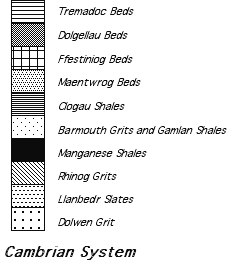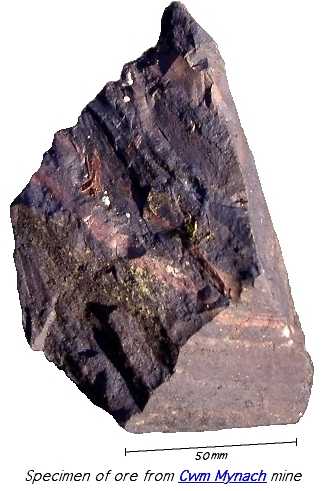Geology
Manganese was mined in two geologically distinct areas of Merioneth: The Cambrian system of the Harlech Dome and the Ordovician system of the Arenig area and the southern slopes of Moelwyn Bach.
Harlech Dome

The Harlech Dome ores form part of the 300m thick sequence of the Hafotty Formation (sometimes referred to as the Manganese Shales or the Hafotty Shales) in the Harlech Grits Group of the Cambrian system (see right). The ore occurs close to (typically about 10m) the base of this formation in a hard flinty sedimentary bedded deposit some .25–.46m thick. Above the ore lies 1.5–1.8m. of so-called bluestone (the miner’s term for the rock) which is a weakly maganiferous mudstone, while underneath the ore is a 50mm bed of pyritous mudstone often rich in crystals of iron pyrites. (The pyrites deposits may have been significant in places, Lletty’r Wialch is described as a sulphur/manganese mine [GAT SMR: 20645] and Harlech Sulphur Mine [GAT SMR: 21827] has the same location as Coed.)
The stratographic column shown is based on George [1961: 17], for a more recent and detailed treatment of this see the Harlech 1:50,000 geological map [BGS 1982] and its associated memoir [Allen & Jackson 1985b].
The ore outcrops extensively from Barmouth north to Harlech, and eastwards to Cwm Mynach, as well as around Cwm Bychan and Nantcol (see map). The thickness of the workable ore varies with .3m being typical, although there are occasional reports of 1.2m thickness.
The ore is a very fine-grained compact rock showing chocolate-red, yellow and, less commonly, bluish-black bands when fresh. The red colour is attributable to hematite dust. (See photograph of specimen below.) At the surface the ore weathers to manganese oxide, in places botryoidal. The constituent minerals of the ore-bed are rhodochrosite (dialogite), spessartine, quartz, minor magnetite, hematite, chlorite, pyrite and rare rhodonite [Allen & Jackson 1985b: 79]. Stefan ab Owain [1988: 38] refers to two types of ore in Ardudwy (the Harlech Dome area) with the local names of mango coch (red manganese [ore], presumably rhodochrosite) and mango du (black manganese [ore], presumably manganese dioxide).
 The sedimentary structures within the ore-bed indicate an origin by precipitation as a colloidal gel, probably of rhodochrosite with clay and silica, simultaneously with iron hydroxides. The spessaerite is a result of regional metamorphism. The source of the manganese being a gneissic land mass [Woodland 1939]. Subsequent studies suggest that the ore formed in a shallow marine basin under reducing conditions where the manganese in the sediment column was extensively remobilised and deposited at the sediment-water interface as rhodochrosite. Fractionation during this process caused the precipitation of iron as sulphide in the underlying sediment [Glasby 1974].
The sedimentary structures within the ore-bed indicate an origin by precipitation as a colloidal gel, probably of rhodochrosite with clay and silica, simultaneously with iron hydroxides. The spessaerite is a result of regional metamorphism. The source of the manganese being a gneissic land mass [Woodland 1939]. Subsequent studies suggest that the ore formed in a shallow marine basin under reducing conditions where the manganese in the sediment column was extensively remobilised and deposited at the sediment-water interface as rhodochrosite. Fractionation during this process caused the precipitation of iron as sulphide in the underlying sediment [Glasby 1974].
Dewey and Dines [1923: 59] refer to Goodchild’s 1893 description of an upper and lower ore bed with a vertical separation of 259m between them (and “for purposes of description” use this classification in their descriptions of mines). Down [1980: 13] mentions a section published in 1886 that showed two beds 1.35m apart. More recently only one bed in the Hafotty formation is recognised [Woodland 1939]. However, some of the existing workings such as Cilcychwyn are difficult to explain unless severe faults or folds are postulated or there are, at least locally, two beds in fairly close stratigraphical proximity. The Moelfre mine abandonment plan of February 1887 shows a section that exhibits localised folding which, if exposed appropriately, would give rise to parallel outcrops of the bed.
Manganese also occurs in the Gamlan Formation. In 1893 Goodchild reported an Upper Manganese Bed in this formation at Ffridd Llwyn Gurfal [Dewey & Dines 1923: 63]. Allen & Jackson [1985b: 10, 79] describe the occurence of manganifierous minerals in this formation as thin (nowhere >50mm thick) and inpersistent. Although two other locations in the Gamlan Formation, Dinas Oleu and Garn, are recorded as being manganese mines, the thinness of the beds makes it unlikely that significant amount of manganese could have been extracted and the surface remains at these sites are not characteristic of manganese mining.
Arenig
The rocks of the Ordovician system surround the Harlech dome and extend westwards into the Lleyn Peninsular and northwards up the western edge of the mountains of northern Snowdonia. Manganese ores appear to be associated with the Arenig series of the Ordovician in the vicinity of Llyn Arenig Fawr, the southern slopes of Mochogryn and Arenig Fach (see map), on the southern slopes of Moelwyn Mawr and also in the Lleyn peninsular (where manganese was mined at Benallt and Rhiw) and elsewhere in Caernarfon (where there were other small-scale manganese mining activities).In the Arenig area the ore forms an infilling in joints and faults in the rocks forming pockets and vein-like deposits similar to those found with other metalliferous ores. (Fron Feuno near Bala seems to be an exception to this with a bedded deposit.) The country rock is a felspathic ash, generally greenish-yellow but frequently stained by iron oxides. To a lesser extent the ore is also found in the lavas and intrusive rocks associated with the ash. The ore is frequently accompanied by small veins of quartz. The prevailing mineral is psilomelane, but pyrolusite has occasionally been found. [Dewey & Bromehead 1915: 53] Cotterell [2006] describes Mynydd Nodol, Nant-yr-helfa and Mochowgryn as being dominated by hollandite (Barium manganese oxide) forming hard, black, botryoidal masses
The Arenig ores were much richer (up to 54% manganese) than the 25–35% of those of the Harlech area. The veins were near-vertical and up to 1.8m wide, but were very limited in extent. Not all the deposits were as large as this however. In 1898 D W Davies surveyed manganese, slate and freestone deposits at Arenig Bach Quarry and reported manganese “in very limited quantities in the small crevices traversing the south western slopes of Arenig Bach”. Although the ore was 45% manganese, some of the ‘crevices’ were only 1" (25mm) wide. (He went on to say that he could “not recommend any great outlay of capital in exploring for manganese in that locality”.) [GAS DAO: Z/DDD/2/943]
Halse [1892: 948] reports that the manganese is believed (no citation) to be a recent deposit in the veins as the result of leaching from the surface erosion and decomposition of the felspathic ashes and igneous intrusions of the area. George [1961: 18] describes the Lleyn manganese ores as appearing “to have originated under the influence of manganese solutions (perhaps associated with volcanic sources) by alteration in part of chamostic mudstones, in part of keratophyric tuff. The rocks were broken into strips and lenticles by thrusting and shearing”. It is possible that this mechanism would apply in the case of the ores in the Arenig and south Moelwyn areas.
| Front page |